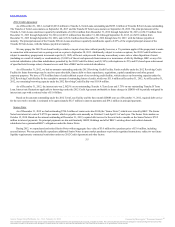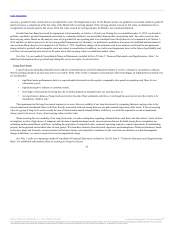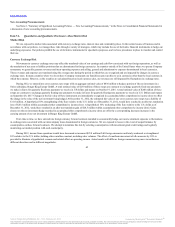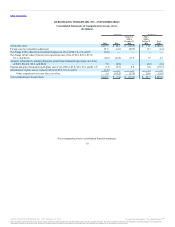Burger King 2012 Annual Report Download - page 63
Download and view the complete annual report
Please find page 63 of the 2012 Burger King annual report below. You can navigate through the pages in the report by either clicking on the pages listed below, or by using the keyword search tool below to find specific information within the annual report.
Table of Contents
We record income tax liabilities utilizing known obligations and estimates of potential obligations. A deferred tax asset or liability is recognized whenever
there are future tax effects from existing temporary differences and operating loss and tax credit carry-forwards. When considered necessary, we record a
valuation allowance to reduce deferred tax assets to the balance that is more likely than not to be realized. We must make estimates and judgments on future
taxable income, considering feasible tax planning strategies and taking into account existing facts and circumstances, to determine the proper valuation
allowance. When we determine that deferred tax assets could be realized in greater or lesser amounts than recorded, the asset balance and income statement
reflect the change in the period such determination is made. Due to changes in facts and circumstances and the estimates and judgments that are involved in
determining the proper valuation allowance, differences between actual future events and prior estimates and judgments could result in adjustments to this
valuation allowance.
We file income tax returns, including returns for our subsidiaries, with federal, state, local and foreign jurisdictions. We are subject to routine
examination by taxing authorities in these jurisdictions. We apply a two-step approach to recognizing and measuring uncertain tax positions. The first step is to
evaluate available evidence to determine if it appears more likely than not that an uncertain tax position will be sustained on an audit by a taxing authority,
based solely on the technical merits of the tax position. The second step is to measure the tax benefit as the largest amount that is more than 50% likely of being
realized upon settling the uncertain tax position.
Although we believe we have adequately accounted for our uncertain tax positions, from time to time, audits result in proposed assessments where the
ultimate resolution may result in us owing additional taxes. We adjust our uncertain tax positions in light of changing facts and circumstances, such as the
completion of a tax audit, expiration of a statute of limitations, the refinement of an estimate, and interest accruals associated with uncertain tax positions until
they are resolved. We believe that our tax positions comply with applicable tax law and that we have adequately provided for these matters. However, to the
extent that the final tax outcome of these matters is different than the amounts recorded, such differences will impact the provision for income taxes in the
period in which such determination is made.
We use an estimate of the annual effective tax rate at each interim period based on the facts and circumstances available at that time, while the actual
effective tax rate is calculated at year-end.
We carry insurance to cover claims such as workers’ compensation, general liability, automotive liability, executive risk and property, and we are self-
insured for healthcare claims for eligible participating employees. Through the use of insurance program deductibles (ranging from $0.1 million to
$2.5 million) and self insurance, we retain a significant portion of the expected losses under these programs. Insurance reserves have been recorded based on
our estimates of the anticipated ultimate costs to settle all claims, on an undiscounted basis, both reported and incurred-but-not-reported (IBNR).
Our accounting policies regarding these insurance programs include judgments and independent actuarial assumptions about economic conditions, the
frequency or severity of claims and claim development patterns and claim reserve, management and settlement practices. Since there are many estimates and
assumptions involved in recording insurance reserves, differences between actual future events and prior estimates and assumptions could result in
adjustments to these reserves.
62
Source: Burger King Worldwide, Inc., 10-K, February 22, 2013 Powered by Morningstar® Document Research℠
The information contained herein may not be copied, adapted or distributed and is not warranted to be accurate, complete or timely. The user assumes all risks for any damages or losses arising from any use of this
information, except to the extent such damages or losses cannot be limited or excluded by applicable law. Past financial performance is no guarantee of future results.
























